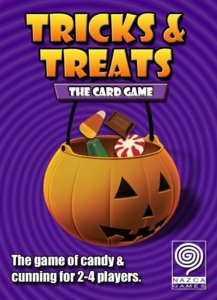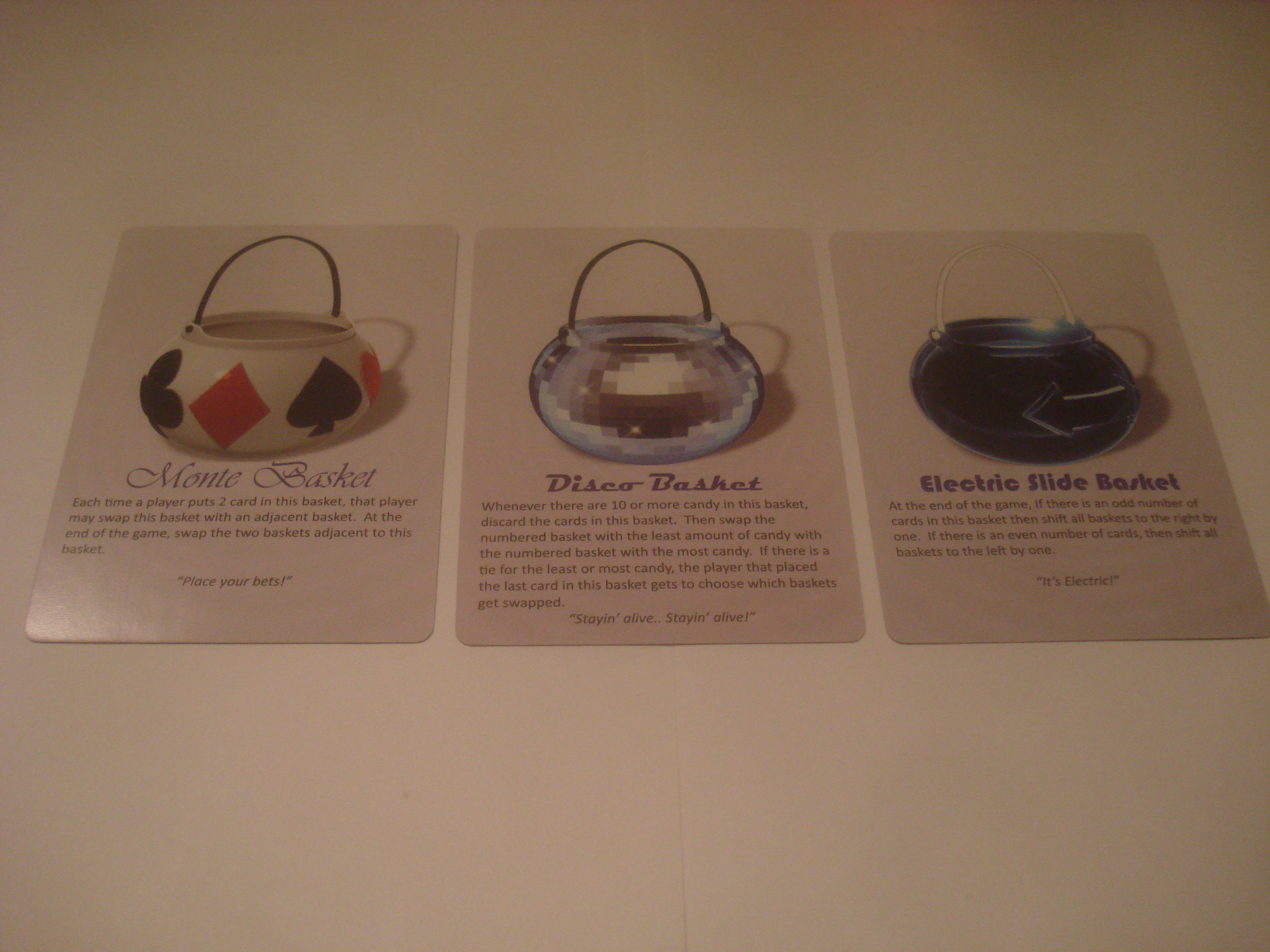| Publisher | Nazca Games |
| Design Credits | Emerson Matsuuchi |
| Game Contents | 48 candy cards, six basket cards, six secret number cards, 11 special basket cards, one Time’s Up! card, rules |
| Guidelines | Anonymous Hallowe’en candy-amassing card game |
| MSRP | $11.99 |
| Reviewer | Andy Vetromile |
The wind howls and the branches creak, the moon hangs low and you know the scariest time of year is upon you: having to share your Hallowe’en candy with your siblings. Worse yet is having to share it with charity. Mom and Dad have you fill numbered baskets so no one knows who’s getting which one and the divisions are fair. You kids weren’t supposed to know, at any rate, but you sneaks found your names written down and are trying to siphon as much candy into your basket as possible without anyone tattling on them. Why go trick-or-treating when you can have both Tricks & Treats?
The object is to have the most candy at the end of the game.
Numbers are secretly assigned to two to four rambunctious kids (or their nominally adult counterparts); these match numbered baskets on the table. Two containers are secretly earmarked for charities so there’s a target-rich environment ripe for a little bluffing. With a small hand of candy cards the trick-or-treaters place one every turn into a basket – but you can’t afford to look like you favor one container over another without someone accusing you of cheating. A kid can name a player and the basket they think is theirs and, if they’re right, the guilty party is out and the tattletale gets to keep that player’s number card for five extra points. If he’s wrong, the unjustly targeted child gets to keep the accuser’s card and that person is eliminated from the running and sent to bed early.
The candy cards come in four, er, flavors: candy corn, gumdrops, chocolate, and peppermints. They display one to four pieces per “suit” three times (a total of 48 cards), so there are peppermints numbered one to four three times and so on. One of the half-dozen candy cards near the bottom is actually the Time’s Up! card shuffled in and when it pops out the game ends. The person who amassed the most pieces of candy wins.
Not enough sugar-induced madness? Throw in the special baskets. These extra containers come with special powers that change how the game is played. The Electric Slide basket, for example, may shift the numbered baskets left or right at the end of the game, changing the contents. Cards played into the Magnet basket allow someone to undo the last card played, the Bomb is a hot potato that destroys containers at the end of the game, and some make certain kinds of candy more or less valuable or desirable.
The graphics for the game are simple but serviceable – after all, how fanciful does a peppermint candy illustration have to be? The cards are colorful and ready for small hands and big eyes, and anyone who wants nifty graphics with their sugar high can point to the special baskets for an edge. Those all have whimsical designs and share the candy cards’ bright hues. It might have been worthwhile to add a little more design flair to numbered basket cards since their color schemes tend to blend a bit with certain pairs, but the numbers make the distinction even if the tinting doesn’t. The Time’s Up! card should have shared the candy card backing so it could shuffle incognito into the last few cards of the deck.
It may be a simple game, simple rules, and simple execution, but Tricks & Treats is still a sweet delight. The balance between filling your basket a lot while filling its anonymous brethren a little (some of which belong to your opponents) is irritating in the best way, and it holds up well even when placed in comparison with the recent surfeit of “hidden role” games flooding the market whose mechanics are more involved. It only takes about 10 minutes to play so the little ones won’t lose interest too easily, and if they do the special baskets keep the action fresh. Some special baskets are off-putting to serious gamers – with already limited options for action, if the game might end with everything shifting one space to the left it makes one’s efforts seem random and some may feel they have too little real input into their endgame. It’s not deeply steeped in strategy so these cards may make a good change-of-pace, but players should agree going in how much of that very little control they’re willing to give up.
Whether an intentional mechanic or a side-effect of Nazca Games‘ quirky design, since there are only so many ways to play cards and look innocent, this ends up being a really social game. Table talk reigns, trying to talk up (or down) the virtues of one basket over another and getting inside one another’s heads or under the skin. Anything that turns face-to-face gaming into in-your-face gaming is to be commended. Tricks & Treats brings both halves of its namesake to the table in equal measure.



